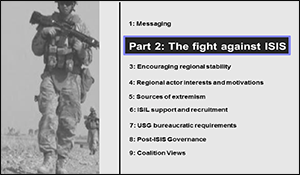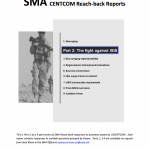Part 2 Learning From the Fight Against ISIS

SMA CENTCOM Reach-back Reports – Part 2: The Fight Against ISIS.
Author | Editor: SMA Program Office.
This is Part 2 of a 9 part series of SMA Reach back responses to questions posed by USCENTCOM. Each report contains responses to multiple questions grouped by theme.
At the request of United States Central Command (USCENTCOM), the Joint Staff, Deputy Director for Global Operations (DDGO), jointly with other elements in the JS, Services, and U.S. Government (USG) Agencies, has established a SMA virtual reach-back cell. This initiative, based on the SMA global network of scholars and area experts, is providing USCENTCOM with population based and regional expertise in support of ongoing operations in the Iraq/Syria region.
The Strategic Multi-Layer Assessment (SMA) provides planning support to Commands with complex operational imperatives requiring multi-agency, multi-disciplinary solutions that are NOT within core Service/Agency competency. Solutions and participants are sought across USG and beyond. SMA is accepted and synchronized by Joint Staff (JS/J-3/DDGO) and executed by ASD(R&E)/EC&P/RRTO.
Responses were submitted to the following CENTCOM Questions:
- Question (QL2): What are the strategic and operational implications of the Turkish Army’s recent intervention in northern Syria for the coalition campaign plan to defeat ISIL? What is the impact of this intervention on the viability of coalition vetted indigenous ground forces, Syrian Defense Forces and Jabhat Fatah al-Sham (formerly ANF)?
- Question (LR 4): What is the strategic framework for undermining ISIL’s “Virtual Caliphate?”
- Question (V3): What long-term actions and processes should U.S. government (USG) institutions, the Coalition and the international community examine to position ourselves against a long term ISIL threat? How can the private sector be effectively engaged by government institutions to optimize the effects needed for success?
- Question (V6): What are the strategic and operational implications of the Iran nuclear deal on the US-led coalition’s ability to prosecute the war against ISIL in Iraq and Syria and to create the conditions for political, humanitarian and security sector stability?
- Question (R2.1): Have sentiments changed since the December 2014 polling? Have recent IO efforts in Mosul influenced these sentiments? What other means can we use to influence?
- Question (R2.5): What are potential unanticipated complications or reactions (or “black swans”) with respect to defeating ISIL in al-Raqqah?
- Question (R3.2): How does Da’esh’s transition to insurgency manifest itself, and what actions should the Coalition take to minimize their ability to maintain either military effectiveness or popular support?
- Question (R3.7): How does Da’esh’s transition to insurgency manifest itself in Syria; which other jihadist groups might offer the potential for merger and which areas of ungoverned space are most likely to offer conditions conducive for Da’esh to maintain some form of organizational structure and military effectiveness?
- ViTTa Special Topic: Mosul Coalition Fragmentation: Causes and Effects

Comments